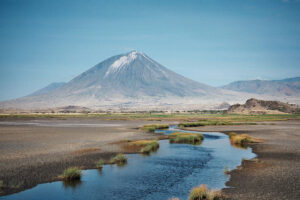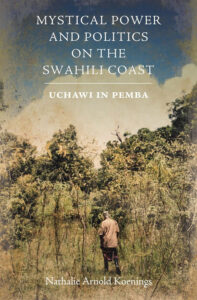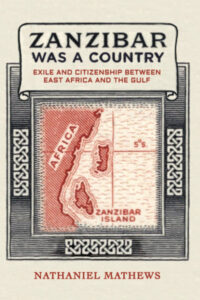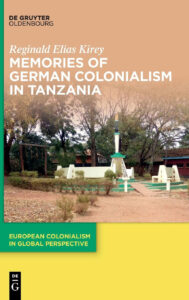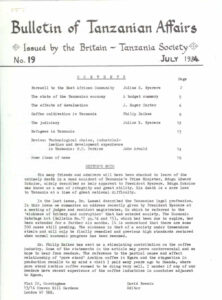by Donovan McGrath
Tanzania opposition laments its ‘naivety’ over president as repression intensifies
(Guardian online – UK) Recent killings and arrests of government critics suggest end of reformist approach under Samia Suluhu Hassan, say political rivals. Extract continues: When Samia Suluhu Hassan took office as Tanzania’s president in 2021, many in the east African country hailed what they hoped was a new dawn after the authoritarian and repressive rule of her predecessor John Magufuli. The signs were positive in her first few years in office: Hassan ended bans on newspapers and political rallies, and legislation that kept pregnant girls and young mothers out of school, all policies that Magufuli endorsed. But opposition leaders say recent killings of officials, a spate of disappearances, and arrests of government critics and bans on opposition gatherings suggest the end of the reformist approach. In late November the Chadema opposition party said three of its members were killed in incidents linked to local elections, which the governing Chama Cha Mapinduzi party (CCM) won in a landslide. Chadema’s chair, Freeman Mbowe, said on X that one candidate was shot dead by police in Tanzania’s commercial capital, Dar es Salaam, as he attempted to stop “fake and invalid ballots” being delivered to a polling station. Chadema said another candidate was shot dead at his home in Mkese in central Tanzania and that a party official was killed in a machete attack at his home in Tunduma near the border with Zambia. … [The] ACT Wazalendo opposition party said the head of its youth wing had been found alive on a beach with serious injuries after an apparent abduction. The party claimed that Abdul Nondo was “kidnapped” … by individuals they believed were state security agents. Police said investigations were continuing to identify those responsible. The deaths follow the killing … of a member of the Chadema secretariat who was found beaten with his face doused with acid. There is no evidence that Hassan has had any involvement in the deaths, which have been condemned by the government. In an interview with the Guardian, Tundu Lissu, another Chadema leader, said that, with the benefit of hindsight, his party’s expectations about political freedoms under Hassan “were wildly, wildly unrealistic”… He said: “She inherited the state machinery which was created by Magufuli and which was responsible for the repression that we went through for six years. How could we have thought that, given all this baggage, this would be a reformist?” An ardent campaigner for democracy, human rights and anti-corruption, Lissu was shot 16 times in an assassination attempt in 2017 that forced him to live largely in exile in Belgium for five years. No one has been charged with the attempt on Lissu’s life. … [The] events of the past few months have reignited fears of a return to intolerance. “She has done with a smile what Magufuli did with a snarl,” said Lissu. (9 December 2024)
Rescuers search for survivors after building collapses in Tanzania, killing at least one
(Guardian online – UK) Dozens of people were trapped in underground shops after collapse of multi-storey building in Dar es Salaam. Extract continues: Rescuers were using their bare hands, drills and sledgehammers to reach dozens of people trapped under a building that collapsed in the centre of Tanzania’s commercial capital, Dar es Salaam. The multi-storey building in Kariakoo, the East African country’s busiest market, caved in as people were shopping, killing at least one person, the prime minister, Kassim Majaliwa, said. Hundreds of people, including army rescuers, clawed through the piles of rubble in the hunt for survivors, alongside excavators. At least 56 people had been rescued, the Tanzanian Red Cross Society said on X. … In 2013, a 16-storey building collapsed in Dar es Salaam and killed 34 people. (16 November 2024)
Firm disclosed phone data of shot Tanzanian politician, UK tribunal hears
(Guardian online – UK) Tigo’s former investigator claims he was unfairly dismissed for raising concerns over 2017 attack on Tundu Lissu. Extract continues: Gunmen tried to assassinate a Tanzanian opposition politician after a telecoms company secretly passed his mobile phone data to the government, according to evidence heard in a London tribunal. The mobile phone company Tigo provided 24/7 phone call and location data belonging to Tundu Lissu to Tanzanian authorities in the weeks before the attempt on his life in September 2017. The arrangement, which Tigo does not deny, was revealed in a claim by a former internal investigator for the company that was heard at the Central London employment tribunal. … Michael Clifford, a former Metropolitan police officer, claims that Millicom, the owner of the Tigo brand, sacked him for raising concerns about the affair. … Lissu was attacked in his car in the parking bay of his parliamentary residence in Dodoma on 7 September 2017. The car was sprayed with bullets and he received severe injuries. Nobody has been prosecuted for his attempted murder. Five days later, Clifford began investigating after hearing on a conference call that Millicom had been providing Lissu’s mobile phone data to the Tanzanian government. He later handed a summary of his findings to his superiors, his lawyer said. The report concluded that “information had been provided to the Tanzanian government since 22 August 2017”, the lawyers said. “From 29 August 2017, the intensity of the tracking increased and [Millicom] used its human electronic resources to livetrack 24/7 the location of two of Mr Lissu’s mobile phones.” The data was passed to the government via WhatsApp messages, which Millicom was later asked to delete. No formal legal request for the data appeared to have been filed. “In the claimant’s reasonable belief, this information tended to show that [Millicom] was involved in an attempted political assassination and act of terrorism,” Clifford’s lawyers said. Clifford claims that after escalating his concerns, his relationship with his managers began to break down and they began to marginalise him within the company, before making him redundant in the autumn of 2019. Millicom disputes Clifford’s claim. … (24 September 2024)
Scientists warn of impending eruption after spotting bulging around ‘Mountain of God’ volcano capable of spewing lava 10 miles away
(Daily Mail online – UK) Extract: Scientists are warning of an impending eruption in Tanzania after discovering the country’s ‘Mountain of God’ volcano is bulging. The Ol Doinyo Lengai volcano, located in the north, was found to be swelling due to magma flowing beneath the Earth’s surface. The 9,718-foot-tall volcano has been active every 20 to 40 years throughout the 20th century, with its last eruption in 2007 spreading ash more than 10 miles away from the site and forcing thousands of people to evacuate. There has been a ‘rapid uplift’ in underground magma volcanic activity in the land surrounding the volcano since March 2022, posing a sign of imminent doom. ‘We have been able to detect transient motion in volcanic activity, and this is a precursor for any kind of eruption,’ said Ntambila Daud, a graduate student at Virginia Tech. Ol Doinyo Lengai – meaning ‘Mountain of God’ in Maasai – is considered to be a sacred site by the Maasai tribe who visit it to pray for cures to illness and infertility and ask for relief from any other misfortunes. Records of the volcano only go back to the 1880s, but it has erupted nine times since with the largest occurring 17 years ago. The explosion sent ash thousands of feet into the air and spread lava nearly two miles away from its western flank. Ol Doinyo Lengai is also the only one in the world to spew carbonite lava, a uniquely black or gray-coloured lava that turns stark white when it cools. This contrasts with other active volcanoes that project red, orange or yellow-coloured lava that will turn a deep black colour when it’s exposed to the air and cools. The different colours relate to the temperature the lave reaches when it hits the surface, with dark red being measured at 887 degrees Fahrenheit, orange at 1,652 degrees Fahrenheit, and white clocking at 2,100 degrees Fahrenheit or higher… Before a volcano erupts, magma will typically gather in a shallow reservoir under the land that causes the Earth’s surface to lift – like a balloon expanding underground… (16 September 2024)
Smiling Sophie, Duchess of Edinburgh, is stylish in statement print frock as she stands in for King Charles during Tanzania visit

The Duchess of Edinburgh at a trachoma outreach camp at Mlandizi Health Centre in Kibaha District – photo Royal.uk
(Daily Mail online – UK) Extract: Sophie, Duchess of Edinburgh was all smiles … as she visited a medical centre during her trip to Tanzania. The mother-of-two arrived in the country earlier this week. During her trip, she will be celebrating how the UK and African nation have collaborated on various issues including health, agriculture and women’s empowerment. … Sophie – who is the global ambassador for the international Agency for the Prevention of Blindness (IAPB) – met with TT surgery beneficiary, Hadija Shaban Kawam and Hon. Jenista Mhagama MP, Minister of Health. The women smiled for pictures as they chatted in front of Hadija’s home in Kibaha. … The duchess also visited the Mlandizi Health Center Tanzania – which offers eye treatment services through the Non-Governmental Organization Sightsavers – so she could see some of the treatments in action. As part of the duchess’ visit, she witnessed a live TT surgery – which corrects trachomatous trichiasis. This is a condition where one or more eyelashes touch the eye due to lid scarring, according to the World Health Organization (WHO). … While at the clinic, she also spoke with Trachoma patient Jumanne Seif Lwambo, during his appointment as well as medic Dr Hiza. Sophie is visiting the African nation solo, flying there to deliver a message from King Charles to the Commonwealth nation. … Charles expressed his ‘gratitude’ for Sophie’s work on the ground, aiding the people who are fighting tropical diseases… (19 September 2024)
Africa’s kleptocrats enable illegal forestry
(Mail & Guardian online – South Africa) Extract: Illegal forestry in Africa thrives where there is conflict and where law enforcement is weak. About 30% of Africa’s forests are fast disappearing because of illegal logging and timber trade, according to the African Union. The unseen effects may be far more devastating in the long term than in the immediate aftermath of the denuded wastelands. Africa’s tropical forests, where illegal logging is most prevalent, are the most carbon-rich ecosystems, storing 150 to 300 tonnes of carbon per hectare (above ground). Mature forests, particularly old-growth ones, have had decades or centuries to accumulate carbon in their biomass and soils. It can take as long for new forests to sequester as much carbon as a mature forest holds. Established forests also contain diverse species that contribute to overall forest health and resilience. A new forest also lacks the biodiversity of an older forest, which can affect its ability to store carbon and withstand stresses such as climate change or disease. When trees are cut down, much of the carbon they’ve stored is released back into the atmosphere as CO2, contributing to global warming. Forests degradation accounts for up to a fifth of global greenhouse gas emissions, the United Nations’ Intergovernmental Panel on Climate Change reported in 2022. One of the worst culprits in Africa is the Democratic Republic of the Congo, which lost more than a million hectares of forest annually from 2010 to 2020, the third highest rate of forest denudation in the world (behind China and Brazil), according to the Global Initiative against Transnational Crime. Kleptocrats on the continent are profiting from the illicit forestry trade, which is estimated by Interpol and the United Nations Environment Programme to be worth $51 billion to $152 billion annually, said Justice Richard Goldstone, vice-chairperson of Integrity Initiatives International, an organisation designed to establish an International Anti-Corruption Court (IACC). He was speaking at Good Governance Africa’s 10th anniversary event … The illegal timber trade in Mozambique is a prime example. The Environmental Investigation Agency’s (EIA’s) multi-year investigation shows that the timber trade not only violates the log export ban, it finances insurgents in Cabo Delgado province, all of which is made possible by systemic corruption in the timber sector. The country loses an estimated half a billion dollars a year to illegal logging trade with China, according to the EIA… In Equatorial Guinea, for example, Teodoro Nguema Obiang Mangue, son of President Teodoro Obiang Nguema, profited hugely from the transport and export of rare hardwoods. As minister of agriculture and forestry, he sold national forests to private companies and used a shell company linked to the ministry to charge fees for processing, loading and transporting timber, Carl Pilgram, of the US-based Africa Center for Security Studies, and Catherine Lena Kelly, of the National Defense University in Washington DC, reported in The Conversation … “In 2021, the Zambian Anti-Corruption Commission seized 47 trucks containing illegal rosewood bound for Namibia and Zimbabwe… stated the report. “In 2019, Gabon’s vice-president and minister of forestry were part of a rosewood trafficking scandal.” … One of the most powerful incentives for governments to get their house in order is public pressure, and in the case of the forestry industry, it ideally comes from the very communities affected by deforestation and in whose interests it is to protect their forests. Forest conservation projects based on equitable partnerships with local residents and characterised by innovative and transparent revenue-sharing agreements are a powerful mitigant against bad actors in governance. An example is Carbon Tanzania, which generates value for Tanzania’s economy and its people by producing nature-based carbon credits that enable local people to earn revenues from the protection of their landscapes… (26 October 2024)
Samia heads to Cuba to promote Kiswahili, health ties
(East African online – Kenya) Extract: Tanzanian President Samia Suluhu Hassan is expected to arrive in Cuba . . . for a three-day state visit that officials say will strengthen bilateral ties between the two countries, with a special focus on promoting the international use of Kiswahili language. During the November 6 to 8 visit, President Hassan will hold talks with her host, President Miguel Diaz-Canel Bermudez, on new economic and diplomatic partnerships to address the global challenges for mutual benefit, a dispatch said. They will explore strategies to open up new avenues for cooperating alliances in areas such as health, education, arts, sports, tourism and the emerging blue economy, Tanzania’s foreign ministry said. Despite five decades of US sanctions, Cuba has managed to build a public health system that is among the best in the world… A major item on Samia’s itinerary will be her attendance as chief guest at the opening of the International Kiswahili Conference in Havana on … the last day of her trip. The conference, the first of its kind, has been organised by Tanzania’s envoy to Cuba, Humphrey Polepole, as part of an initiative to promote the use of Kiswahili in the Caribbean and South America… The two leaders will also launch a new Spanish-to-Swahili dictionary and booklet of common sayings in both languages, produced jointly by the University of Dar es Salaam and the University of Havana… (6 November 2024)


